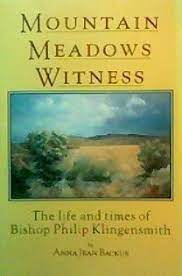Articles/Essays – Volume 30, No. 2
A Quest for Understanding | Anna Jean Backus, Mountain Meadows Witness: The Life and Times of Bishop Philip Klingensmith
At last, an absorbing sequel to Juanita Brooks’s momentous work, The Mountain Meadows Massacre. Just when Mormon church leaders and scholars alike were ready to accept that Brooks has the last, if not final, word on where lay the responsibility for the slaughter of the Fancher/Baker wagon train, along comes Anna Jean Backus with her revealing first book: Mountain Meadows Witness: The Life and Times of Bishop Philip Klingensmith. Designed as a quest for understanding, and, like Brooks who professes her loyalty to the Mormon faith, Backus feels, as stated in her introduction: “A kinship with descendants of surviving children of the massacre and an empathy for descendants of the participants. These feelings compel me to further the healing process that has begun on both sides of this tragic event.”
Unlike Brooks, Backus goes be yond the now standard acceptance of shared guilt among William H. Dame, John M. Higbee, Isaac C. Haight, and John D. Lee by addressing Philip Klingensmith’s sworn testimony in Lee’s first trial, convening in Beaver, Utah, on 23 July 1875, naming George Albert Smith, apostle, as General Commander over William H. Dame, thus making Smith the real head of the Iron County militia. Smith, a colonel in the Nauvoo Legion, took command of the Southern Militia Department on 25 July 1853. How could Smith not know of the planned massacre? In reference to Apostle Smith’s involvement in the election of officers for the Iron County Militia on 28 July 1857, just prior to the massacre, Backus refers to Klingensmith’s testimony: Q. “Was George A. Smith down there about that time?” A. “Not that I recollect; I didn’t see him.” Q. “Do you remember before this occurrence?” A. “No, sir, not to my knowledge.”
Backus’s interpretation of Klingensmith’s testimony is: “Philip may not have seen him but probably heard about George A. Smith’s being in the area before the massacre. Most likely, Philip was evading the truth on this point. His testimony protected an event he was not likely to forget.” She further states: “George A. Smith, in his affidavit for the trial of John D. Lee, denies holding any military command during the year 1857. Evidence shows that he did—giving cause to wonder why he was evading the truth.”
The preceding statements by Backus, based on Smith’s affidavit, read at Lee’s second trial on 14 September 1876, are therefore understandable.
History records that seventeen children who survived the massacre were returned to Carrollton, Carroll County, Arkansas, on 15 September 1859. However, it has always been contended that there were more children spared, perhaps as many as nine teen. Backus is convinced that she is a direct descendant of Alexander and Eliza Fancher who were murdered by the Mormons and their Indian allies at Mountain Meadows. She contends that Klingensmith, after the massacre, took one of the Fancher children, a baby girl, and gave her to his third wife, Betsy, to be raised a Mormon and given the name Priscilla Klingen smith, as revealed by Backus in her preface. The child was not returned to Arkansas in 1859 with the other seventeen children comprising the Forney Party. Backus offers substantial evidence, if not conclusive proof, that Priscilla (Klingensmith) Urie was her grandmother Urie, thus adding credibility to the long suspected existence of an eighteenth child.
In her compulsive quest for our acceptance of Klingensmith’s minor role in the massacre and subsequent efforts to save, protect, and find homes for the very young children, Backus seeks our compassion and forgiveness for her great-grandfather. She further states in her introduction: “Because of the way I have written my book, I feel that Philip Klingen smith has been with me, talking to me, all the way to the end.”
Backus appeals for our understanding, to judge her great-grandfather’s actions, by the prevailing social and religious conditions existing in southern Utah at the time of the massacre. As a bishop of the LDS church, Klingensmith acknowledged the hierarchy of the church leadership. He feared both for his spiritual and physical life if he were to disobey their counsel. Basically, he simply did what he was told. Further, she concludes that her great-grandfather, like John D. Lee, was a scapegoat for higher ranking church and militia leaders.
Unlike Lee and Haight who were excommunicated from the church by Brigham Young in 1870, it is not clear when, if ever, Klingensmith was ex communicated. What is clear, though, is that his confession to Charles W. Wandell in 1871, which led to a series of scathing attacks against the church leadership and later his testimony at the Lee trial, did lead to Klingen smith’s banishment from the church after being protected by Young’s former tolerance policy. Also, unlike Lee and Haight, who were both rein stated to full fellowship in the church, Klingensmith remains unloved, un wanted, and misunderstood. The fore going sentiments help explain Backus’s appeal for mercy (218-20).
Anna Jean Backus has made a substantial contribution to our knowledge of Bishop Philip Klingensmith. His role in the Mountain Meadows massacre has been thoroughly re searched. Some minor errors do ap pear. William H. Tackett, one of the seventeen surviving children returned to Arkansas, is buried in Protem, Missouri, not Proteus, as cited on page 168; further, footnote 18 is missing on page 168. Mountain Meadows Witness is both informative and enjoyable to read, a long overdue addendum to American history.
Mountain Meadows Witness: The Life and Times of Bishop Philip Klingensmith. By Anna Jean Backus (Spokane, WA: The Arthur H. Clark Co., 1996).


 Back to full Issue
Back to full Issue

